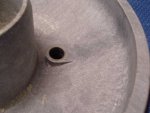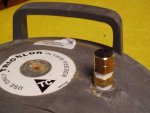Aging trichlor feeder has two pressure release valves on the cover. One of them has threads so stripped that the only fix is to plug the hole completely. What kind of goop should I use to fill in that hole? This is the most oxidation-intense locale in the whole system so I have concerns about what sealant could survive in that chemical environment.
Details: With threads deteriorated it's about a 3/8" hole now. Don't know what kind of plastic the cover is. I don't use the feeder except when a bump in CYA is needed, so its duty is limited but occasionally essential for pacifying the health inspector of this public pool. Parts for this feeder are no longer available, so the alternative is complete replacement, which is difficult to stomach ($$$) given that our primary chlorine source is not trichlor.
Thanks!!!
Details: With threads deteriorated it's about a 3/8" hole now. Don't know what kind of plastic the cover is. I don't use the feeder except when a bump in CYA is needed, so its duty is limited but occasionally essential for pacifying the health inspector of this public pool. Parts for this feeder are no longer available, so the alternative is complete replacement, which is difficult to stomach ($$$) given that our primary chlorine source is not trichlor.
Thanks!!!



